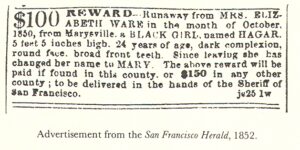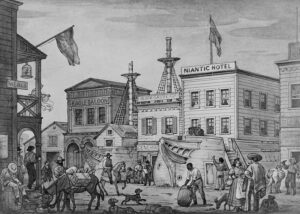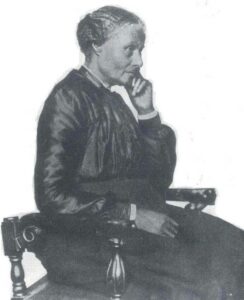The California Gold Rush, from 1848 to 1860, began after gold was discovered by carpenter and sawmill operator James W. Marshall on January 24, 1848. After Marshall’s discovery, thousands of people came to the goldfields in the foothills of the Sierra Nevada mountains in Northern California. At least 4,000 African Americans were among those who would arrive in California by 1860 in search of gold and more generally, prosperity and freedom.
In 1850, 952 African Americans resided in California, with the male population comprising 91 percent of that number. The population doubled to 2,000, still mostly men by 1852. A few African American gold-seekers founded wealth during the gold rush. In 1848, one African American man named Hector deserted his naval squadron ship Southampton at Monterey, California, and went to the mother lode. He returned a few weeks later with $4,000 in gold. Peter Brown, formerly of St. Genevieve, Missouri, was more typical. Working 25 miles from Sacramento in December 1851, he cleared $400 after two months of work.

African American miners usually worked in integrated settings in Chinese, Latin American, and European companies. In 1852, a small African American community called Little Negro Hill grew up around the lucrative claims of two Massachusetts-born African American miners working along the American River. Little Negro Hill was known to attract Chinese and Portuguese miners and American-born whites.
Other integrated mining settlements emerged including a second Negro Hill near the Mokelumne River, Union Bar along the Yuba River, and Downieville, which was founded in 1849 by William Downie, a Scotsman who led nine miners, including seven African Americans, to the location where the town was formed.

Far more African Americans were successful providing services to the gold-driven economy. Most of these newcomers settled in Sacramento and San Francisco. Mifflin Gibbs and Peter Lester, formerly of Philadelphia, Pennsylvania, started the Pioneer Boot and Shoe Emporium whose customers stretched from Portland, Oregon Territory, to Baja California. James P. Dyer, formerly of New Bedford, Massachusetts, became the West’s first antebellum Black manufacturer when he started the New England Soap Factory in San Francisco in 1851.
Although nominally a free state, slavery also existed in California. In 1852 a fugitive slave law was passed that made it illegal for slaves to flee their masters around California borders. Advertisements for runaway slaves also appeared in local newspapers. An estimated one third of the African Americans in California were illegally enslaved. They often resided in the cities or goldfields and mining camps living and working alongside free Blacks. Their presence led to an abolition movement especially in San Francisco, Oakland, Sacramento, and other cities.

The goldfields in California provided a temporary home for African American miners. Most African Americans became permanent urban residents, creating Black communities in San Francisco, Sacramento, Marysville, and other cities and towns. Between 1849 and 1855, most African American residents in San Francisco settled near the waterfront and expanded their community to Telegraph Hill. Blacks in both Sacramento and San Francisco created churches that anchored these communities. In 1850, for example, Sacramento African Americans founded St. Andrews AME Church, the first Black church west of Texas. The gold rush established a number of African American communities in California including many which continue to this day.

